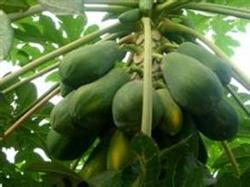High-yield cultivation techniques of papaya

Papaya belongs to the genus Chaenomeles of Rosaceae. Its fruit is rich in nutrition and has high medicinal value. In this paper, the key points of cultivation techniques for high yield papaya in field are introduced as follows: planting papaya is suitable for close planting, mountain and hilly land, plant row spacing is generally 1.5m × 3m, flat land with good fertilizer and water, plant row spacing is 2m × 4m m, and when intercropping with grain and vegetables, row spacing is 3m × 5m × 6m. Papaya can be planted in spring or autumn. After planting, it can be dried at a place of 70m / 80cm on the ground. When sprouting, the sprouts within 50 cm of the root tiller and the base of the trunk should be wiped out in time, and the overdense shoots should be properly removed. Soil fertilizer and water management papaya has strong adaptability, the opposite soil requirements are not strict, resistant to barren, more tolerant to salt and alkali, not resistant to waterlogging. The base fertilizer of papaya orchard is mostly applied in autumn, and the amount of base fertilizer accounts for about 70% of the total amount applied in the whole year. Topdressing should be carried out in the period of maximum fertilizer effect according to the growth and fruit of papaya trees. In the full fruit period, the tree should apply pre-flowering fertilizer, post-anthesis fertilizer and fruit expansion fertilizer in time, and 0.2% urea and 0.2% potassium dihydrogen phosphate should be sprayed in combination with pest control, and phosphate and potassium fertilizer should be applied in the fruit expansion period. When base fertilizer was applied in autumn, the fruit tree was treated with 10 kg organic fertilizer per tree, and 0.5 ml 1.0 kg ternary compound fertilizer was mixed. Irrigate once after fertilization and pay attention to water control at flowering stage. After planting in arid areas, the tree plate should be covered with plastic film or grass to preserve soil moisture. After shaping and pruning, the middle stem of the papaya tree is relatively upright, and after a little pruning, it can be shaped into a cup-shaped, cylindrical or slender spindle shape, with a height of 2.1mi 2.3 m, a crown diameter of 1.2m and a stem height of 0.5m. There are 812 staggered main branches on the trunk, and the distance between the adjacent main branches is 2030cm. There are three groups of fruiting branches on each main branch. The main branch should be released slowly to promote the growth of medium and short branches. Pruning is mainly sparse, and attention should be paid to cutting off competitive branches in the middle stem, long branches in the crown, over-dense branches, thin and weak branches, disease and insect branches and so on. The branch deficiency site can leave 1 Mel and 2 buds truncated to promote branching, and the senescent fruiting branch group should be retracted and renewed in time. The main diseases and insect pests of papaya are: leaf spot disease, ring disease. Anthracnose, dry rot, aphids, red spiders, papaya borer, peach heart borer, pear planthopper, diamondback moth, etc. Control methods: spray imidacloprid EC 3000 times in early March, spray 30% peach Xiaoling EC 500 times and 50% carbendazim wettable powder mixture in late May to early June and early July respectively to control papaya borer, diamondback moth, peach heart borer and leaf spot, etc., from late July to before defoliation Alternately sprayed 70% mancozeb 800 times solution, 50% carbendazim wettable powder 600 color 800 times solution, equal volume Bordeaux solution and other fungicides at intervals of 25 days, sprayed 3 times for 4 times. At the same time, pay attention to the control of all kinds of caterpillars, pear planthoppers and other pests, clean up the orchard after winter, sweep away fallen leaves, stiff fruits, disease and insect branches, and concentrate on burning.
- Prev

Protective measures of cold resistance and anti-freezing in papaya cultivation
Papaya is a tropical crop, like hot climate, avoid low-temperature frost. Freezing injury occurs when the temperature is lower than 5 ℃. It is very important to take the following measures to prevent freezing: re-application of overwintering fertilizer. Each tree is treated with 10kg of organic fertilizer mixed with mature human and animal manure and plant ash, and 1.5 kg of phosphate fertilizer. At 80cm and 100cm from the trunk, dig 2.
- Next

Seedling raising techniques of papaya
Papaya, also known as wrinkled papaya, is the dry nearly mature fruit of Malus rosaceae. it mainly produces Shandong, Anhui, Sichuan, Hubei, Yunnan and Shaanxi provinces. it has the functions of relieving cough and relieving spasm, clearing heat and diuresis, relaxing muscles and activating collaterals, and stomach dampness. in recent years, papaya beverage, papaya wine, preserved fruit, canned fruit and chemical have been developed.
Related
- Moge, come on! The staff of the peasant association in the producing area of cantaloupe were frightened when the crowd gathered.
- Causes and Solutions of low Fruit setting rate of Apple
- Symptoms and control measures of passion fruit virus disease
- Fruit growing lesson: how do apple orchards keep high yields?
- Can you build orchards in the mountains? What are the pros and cons?
- How to manage the coloring period of Crisson grape?
- This paper introduces the processing technology of two kinds of fig products.
- How much is a month for retired teachers in rural areas by 2020?
- How can strawberry planting increase sugar content? We should pay attention to management in many aspects.
- What are the cultivation techniques on how to improve the yield of golden fruit?

